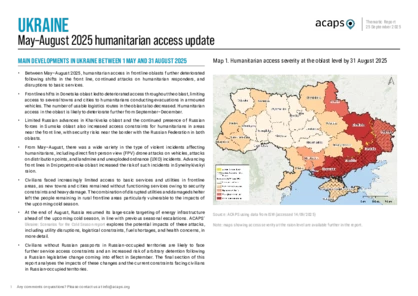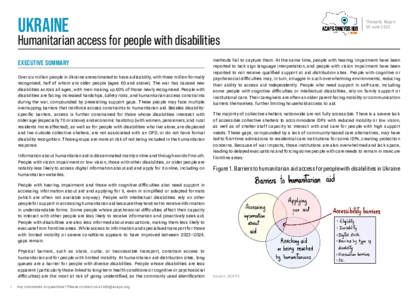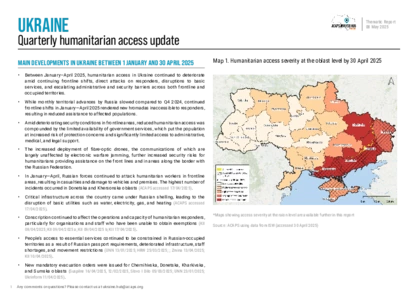Latest updates on country situation
23 September 2025
The water crisis resulting from inadequate water infrastructure in the Russian-occupied territories of Donetska oblast continues to worsen in late 2025. The Siverskyi Donets–Donbas Canal, which serves four million people even after facing damage since the conflict in 2014, has faced increased war-related damage since 2022. Damages to the canal system heightened by strikes on energy infrastructure and a summer drought are limiting water access for civilians who face increased health risks and utility costs. Low water reservoir levels risk reducing the operational capacity of the Zuivska thermal power plant, potentially limiting access to heating during the coming cold season for one-third of people. (Ekonomichna Pravda 17/07/2025, The Insider 25/08/2025, ISW 28/08/2025)
19 August 2025
Between 10–14 August 2025, Russian sabotage groups advanced 10–12km past the front lines east of Dobropillia. New mandatory evacuations were announced, with the remaining population facing constrained access to essential services. From 13–14 August, mandatory evacuations were announced from Bilozerska and Dobropilska hromadas in Pokrovskyi raion and Andriivska hromada in Kramatorskyi raion, where a total of 3,000 children remained. The use of first-person-view drones by the Russian forces further complicates evacuation measures, as they present a high risk to civilians, evacuees, and humanitarian responders directly involved in life-saving evacuation. Increased pressure on the nearest transit centre in Pavlohrad city, Dnipropetrovska oblast, is compounded by the overall lack of collective shelter spaces for evacuees. People who remain in frontline areas generally face more severe needs given diminished essential services and humanitarian response, with older people, people with disabilities, and those with reduced mobility at particular risk of having unmet needs. (Vchasno 15/08/2025, REACH 26/03/2025, (ISW 15/08/2025)
13 August 2025
On 2 August 2025, Russian forces attacked the road bridge connecting Korabelniy microdistrict of Kherson with the rest of the city, causing gas, power, and water disruptions. By 10 August, 1,565 civilians (nearly 87% of Korabelniy's total population), including 56 children and 152 individuals with low mobility, had been evacuated. The humanitarian situation in Kherson continues to deteriorate as Russian forces target the roads and vehicles that humanitarians use for evacuation and the delivery of assistance. (Ukrinform 07/08/2025, Ukrainska Pravda 10/08/2025,
Interfax 12/08/2025)
28 July 2025
Russian authorities are threatening Ukrainian residents living in occupied areas of Donetska, Khersonska, Luhanska, and Zaporizka oblasts with forced displacement should they not accept Russian citizenship within 90 days of 10 September 2025. Added threats include property loss, exposure to winter conditions, family separation, and being stranded on the Russian border for an indefinite period of time. Russian authorities already employ coercive passportisation measures, such as restricting access to healthcare, employment, pensions, and education. (HRW 25/03/2025, Zmina 03/07/2023, AJ 23/07/2025)
14 July 2025
In June 2025, the monthly injury toll (over 1,340 people) in Ukraine reached its highest in the last three years. Russian long-range and short-range drone attacks constitute a significant cause of civilian casualties. During a one-week period in early July, Russian forces launched two consecutive countrywide attacks, with a record-breaking number of drones used (over 500 and 700 drones, respectively). The increased scale and frequency of Russian air attacks in 2025 represent a significant protection risk for civilians. (OHCHR 10/07/2025, ISW 09/07/2025, ISW 04/07/2025)
28 May 2025
Russian forces launched extensive aerial attacks across Ukraine from 23–26 May 2025, including a record 367 drones and missiles on the night of 24 May. The strikes killed at least 12 civilians, injured 70, and damaged both critical and civilian infrastructure. If Ukrainian air defences struggle to keep up with the frequency and intensity of such aerial attacks in the future, threats to civilian safety across Ukraine are likely to increase. (Air Force Command of UA Armed Forces Facebook accessed 28/05/2025, The Economist 25/05/2025, NV 25/05/2025)
15 April 2025
By 9 April 2025, civilian infrastructure damage in Kryvorizkyi raion (Dnipropetrovska oblast) was 40% higher within the year at 98 counts compared to the entire 2024 (70). Most of the damage is to industrial or business facilities, likely affecting the local economy. This increase comes as Russian forces have increased ground conflict intensity in western parts of Zaporizka oblast. (ACAPS accessed 14/04/2025, ISW 09/04/2025, ACLED accessed 08/04/2025)
current crises
in
Ukraine
These crises have been identified through the INFORM Severity Index, a tool for measuring and comparing the severity of humanitarian crises globally.
UKR002 - Conflict in Ukraine
Last updated 22/09/2025
Drivers
Conflict/ Violence
Crisis level
Country
Severity level
4.3 Very High
Access constraints
5.0
Analysis products
on
Ukraine
25 September 2025
Ukraine: May–August 2025 humanitarian access update
DOCUMENT / PDF / 2 MB
This report compares access challenges across Ukrainian raions and oblasts to inform humanitarian responders and support decision-making. It is part of ACAPS’ regular analysis of access constraints, with the latest report published on 8 May 2025.
28 August 2025
Ukraine: scenarios for the cold season 2025–2026
DOCUMENT / PDF / 650 KB
This report details four distinct yet plausible futures for Ukraine during the upcoming October 2025 to March 2026 cold season. The scenarios focus on how the intersection of war dynamics and seasonal conditions may drive distinct cold-season-related needs throughout the country.
Attached resources
10 July 2025
Ukraine: update on developments in Donetska oblast
DOCUMENT / PDF / 335 KB
This report updates ACAPS’ previous analysis on Donetska oblast, reflecting recent developments, including the shift in Russian military operations toward Kostiantynivka.
Attached resources
05 June 2025
Ukraine: humanitarian access for people with disabilities
DOCUMENT / PDF / 526 KB
Over six million people in Ukraine are estimated to have a disability, with three million formally recognised, half of whom are older people. The war has caused new disabilities across all ages, with men making up 60% of those newly recognised.
Attached resources
08 May 2025
Ukraine: quarterly humanitarian access update (Q1 2025)
DOCUMENT / PDF / 9 MB
This report compares access challenges across Ukrainian oblasts and raions to inform humanitarian responders and support decision-making. It is part of the ACAPS regular analysis of access constraints, with the latest report published on 6 February 2025.






